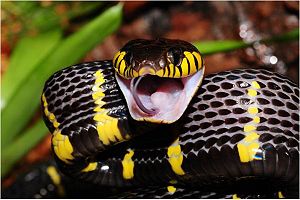Sandbox Reserved 932
From Proteopedia
m |
m |
||
| Line 19: | Line 19: | ||
Denmotoxin is a snake venom protein produced by ''Boiga dendrophila'' ([http://en.wikipedia.org/wiki/Boiga_dendrophila mangrove catsnake]) which belongs to a family of well studied three-fingered neurotoxins. | Denmotoxin is a snake venom protein produced by ''Boiga dendrophila'' ([http://en.wikipedia.org/wiki/Boiga_dendrophila mangrove catsnake]) which belongs to a family of well studied three-fingered neurotoxins. | ||
| + | |||
| + | |||
=== Denmotoxin belongs to a family of non-conventional three-finger toxins === | === Denmotoxin belongs to a family of non-conventional three-finger toxins === | ||
| Line 24: | Line 26: | ||
Three-finger toxins (3FTXs) are the most common family of snake venom proteins with a conserved structure. The core structure of 3FTXs is formed by <scene name='57/579702/Three_fingers/1'>three polypeptide loops</scene> joined together by cysteine bridges. Denmotoxin has several features which classify it as a non-conventional 3FTX. It differs structurally from other elapid 3FTX venoms by its seven additional N-terminal amino acid residues; this unusually long N-terminus is unstructured and is hypothesized to gyrate above the core of the protein. Another unique feature of denmotoxin is the twist at the tip of the central loop originating from a kink in a proline residue (Pro40). At the central loop, the charge is also negative, a tyrosine residue has been replaced with an aspartic acid, which is unusual for the proteins of the family. | Three-finger toxins (3FTXs) are the most common family of snake venom proteins with a conserved structure. The core structure of 3FTXs is formed by <scene name='57/579702/Three_fingers/1'>three polypeptide loops</scene> joined together by cysteine bridges. Denmotoxin has several features which classify it as a non-conventional 3FTX. It differs structurally from other elapid 3FTX venoms by its seven additional N-terminal amino acid residues; this unusually long N-terminus is unstructured and is hypothesized to gyrate above the core of the protein. Another unique feature of denmotoxin is the twist at the tip of the central loop originating from a kink in a proline residue (Pro40). At the central loop, the charge is also negative, a tyrosine residue has been replaced with an aspartic acid, which is unusual for the proteins of the family. | ||
| - | ===Structure=== | ||
| + | |||
| + | ===Structure=== | ||
Denmotoxin is a monomeric protein consisting of 77 amino acid residues. Multiple sequence alignment of denmotoxin reveals that the venom belongs to the family of non-conventional 3FTXs. Denmotoxin has 7 additional amino acid residues in its N-terminal when compared to other elapid 3FTXs; the N-terminus is also blocked by a pyroglutamic acid residue. The biological function of the pyroglutamic acid residue is currently unknown. | Denmotoxin is a monomeric protein consisting of 77 amino acid residues. Multiple sequence alignment of denmotoxin reveals that the venom belongs to the family of non-conventional 3FTXs. Denmotoxin has 7 additional amino acid residues in its N-terminal when compared to other elapid 3FTXs; the N-terminus is also blocked by a pyroglutamic acid residue. The biological function of the pyroglutamic acid residue is currently unknown. | ||
Revision as of 12:43, 15 May 2014
| This Sandbox is Reserved from 01/04/2014, through 30/06/2014 for use in the course "510042. Protein structure, function and folding" taught by Prof Adrian Goldman, Tommi Kajander, Taru Meri, Konstantin Kogan and Juho Kellosalo at the University of Helsinki. This reservation includes Sandbox Reserved 923 through Sandbox Reserved 947. |
To get started:
More help: Help:Editing |
B. Dendrophila monomeric toxin (Denmotoxin) is the primary protein of snake venom used by Boiga dendrophila. This colubrid snake lives in Southest Asian lowland rainforest and mangrove swamps using birds as its primary prey.
One of the most well characterized snake venom protein families is the Three-finger-toxins (3FTX). These proteins consist of three β-stranded finger-like polypeptide loops stabilized by four disulphide bridges on the surface of a globular core. In non-convential 3TFXs a fifth disulphide bridge can be present as is the case in Denmotoxin.
Denmotoxin functions by binding to Muscle Acetylcholine receptors (AChR). The toxin shows high specificity to bird nAChR.
Denmotoxin
| |||||||||||

![Three fingers formed by three peptide loops (F1, F2 & F3) [PDB=2H5F]](/wiki/images/thumb/3/3f/Kolme_sormea_figure_text.png/300px-Kolme_sormea_figure_text.png)
